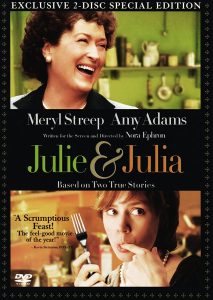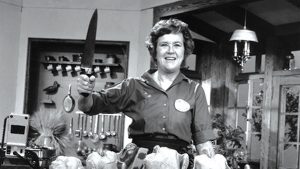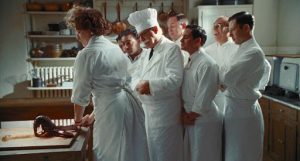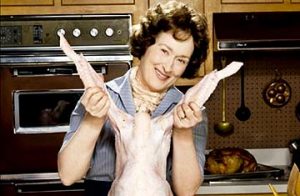Overview

Julie and Julia is a film that tells the story of Julia Child, one of the top chefs of the US and who made home dining more accessible, and of a woman, Julie, living in Queens who sets out to cook all of Child’s recipes from her first cookbook. The film explains the life of Julia Child in Paris and her journey to become one of the most well-known chefs in the world and the author of a pioneer cookbook that changed the cooking scene in the US and abroad as well as the life of Julie, which is set years after the publication of the cookbook and focuses on the struggles of everyday life and the healing qualities of cooking. Julie, a government employee, decides to cook every recipe found in Julia Child’s cookbook, in one year. Julie and Julia tell the story of how food can connect people even when they live apart in both location and in time.
Food in the Film
Food plays a huge role in this film. Both Julia and Julie have based their whole lives around food. The structure of the movie is based around the context of food and the role it plays in the lives of these two women and their families. During her time in Paris, Julia took classes at Cordon Bleu, where she learned the ins and outs of French cuisine. Food allowed Julia to express herself, and it gave her the platform she needed to find her identity. Julie begins cooking all of the recipes in Julia Child’s book because she needed a cause to devote herself to after struggling through the hardships of mundane life. In this sense, food and cooking saved Julie from becoming more disappointed and potentially brought her out of her state of despair. Cooking in both cases saved both Julia and Julie from lives that would have been less fulfilling and gave them a sense of purpose and identity.
Themes
Food as material and Symbolic

In the film, food represented a way for both women to find and express themselves. Both women were living in states of unease and uncertainty, but they both turned to cooking, which saved them from continuing to lead their mundane lives. Cooking is used as a symbol here because it did much more than just sustain the women, it gave them a platform to express who they are and their identities as it’s linked to food. Food represents salvation in this film and a way to start over. Cooking opened doors to successful careers for both Julia and Julie. Julia was able to create her own cookbook, which made her one of the most well-known cooks in the world. In Julie’s case, food created a way for her to share her life, as well as create career opportunities. If it weren’t for cooking and food, then Julie would not have written a book about her experiences and thus this movie would have never existed, and Julie would have been another faceless government employee.
Before Julie decides to cook all of Julia Child’s recipes, we see her baking a chocolate cream pie. While making it, she is telling her husband that she loves cooking, because, in a world of uncertainty, she can come home and know that she can control what she makes and how everything will come together. Even before Julie does her cooking challenge, she finds comfort in cooking, and it brings her a sense of security and control. Food in this case is a symbol of control and power for Julie.
As Julia starts her course at Cordon Bleu, she writes to her friend Avis and says;
“I have been looking for a career all my life and I’ve finally found it”(36:02).
In this scene the audience sees that Julia has finally found her identity, she has been lost all her life and she has never really belonged anywhere. However, as we see in this scene, she found her true passion in life to be cooking.
In the opening scenes, we see Julia Child moving into a huge, luxurious apartment in Paris, then the scene changes to Julie Powell, as she is moving into her small, rundown apartment in Brooklyn. Julia is extremely enthusiastic about her new living situation, while Julie is rather let down and upset. In this scene, we can see the vast differences in both of these women’s lives. One is living an extraordinary life while the other is leading a much more modest one. Food is the reason these two women came together. Without it, their lives would have never been so greatly impacted and changed. As we can, food is much more than just material, but an event that brings people together.
Gender
Gender plays a huge role throughout Julie and Julia. Both of the protagonists are women who have devoted their lives to cooking. Both women are married and spend much of the duration of the film with their husbands, but the husbands never made a meal. It was only Julie and Julia who cooked throughout the entire film. The husbands would always taste the food and they were mostly very supportive of the women, however, we can clear them of gender roles. The role of the woman is stereotypical as the caregiver and the one that does all that cooking. We can see this being played out in the film. Both women devoted their lives to cooking and yet never does the audience see either husband pick up a whisk, let alone cook a meal.
While Julia is in Paris she begins taking classes at the Cordon Bleu. She quickly realized that the class she has enrolled in is for the most basic of cooking and only women are present. So she decides to go to a more advanced class, where she discovers that her fellow classmates are all men. We can see gender playing a huge role in this scene. The men who are taking the advanced classes with Julia Child are training to become career chefs. The implication here is that women were meant to only cook for their families, not as a chef in a restaurant. At first, Julia is not seen as one of them, first, she is tall, loud, and an American, but most of all she is a woman. It is not until later that she is accepted as part of the group after she is the only one fearless enough to kill a lobster for one of the recipes.

Pearls have always been a symbol of femininity. During her career, Julia also made in-home cooking instruction videos, and in every one of these videos, she is wearing pearls. The pearls represent the gender roles that were so prevalent in the 19 hundreds. This is important to note because it further highlights how women were seen as belonging in the kitchen in nice clothes in order to please their husbands and their families.
In class, we talked about how men are more likely to shop, while women are more likely to plan a meal and cook it. We can see these gender roles in this scene. Julie is making aspics, a kind of jelly made of beef stock. The recipe calls for a calf’s foot and Julie specifically states that “her sainted husband” found it for her. Julie then proceeded to finish the recipe, while Mark, her husband, sat and watched T.V. In this scene Julie planned what she was going to cook, and then her husband went out and found it, then left her to cook the meal for him. These events totally match up with what we discussed in class surrounding gender.
Cultural Tourism

The book that Julia Child wrote is in fact a french cookbook for an American audience. The book centers around the traditional and authentic ways of French cuisine. Julia Child wrote this book so that American women would have access to the most popular style of cooking in the world. The audience is drawn to the authenticity of the cuisine as well as the taste, therefore some things, I’m sure, were changed to better suit the taste of an American public. Julia Child was also well known for her in-home video instructions on how to cook the recipes found in her book. She advertised the authenticity of her recipes but presented and altered things in different ways to better reach her audience. People are still captivated by the luxury and style of French cuisine which allowed Child to cater to those desires and produce a cookbook that would bring such luxury into the homes of the average American.
In one scene, Julie is making lobster Thermador, a recipe found in Child’s cookbook. The recipe calls for either boiling the lobsters to death or cutting them open with a kitchen knife. This process can be difficult even for the bravest of cooks. And on top of that lobster can be very expensive. the average cook doesn’t necessarily have the funds nor the fearlessness to kill a live lobster. This recipe displays cultural tourism in a way that expresses the authenticity of the cookbook, but also draws attention to the was a bigger audience to the interesting ways of French cooking.
We see cultural tourism emerge in the scene where Julie Powell and her husband are watching one of Julia Child’s cooking shows. Julia is telling her audience that they need to flip things confidently and without reproach. Julie and Mark are making fun of her distinct high pitch voice. At the end of the instructions, Julia says as she does in every video, “Bon Apetit”. Julia is making French cuisine available to every American cook. However, by saying bon appétit, she is selling the fascination of French cooking to Americans.
Two of Julia Child’s friends were creating a french cookbook for Americans, however, their editor turned them down because the book would not have done well. The editor suggested that they should find a collaborator to make it more appealing to American audiences, thus they ask Julia to help them. The term used was that the book was not English enough. We can see cultural tourism here as well. The friends are trying to sell French cuisine and culture to an American audience, but it wasn’t altered enough for the tastes of Americans so they have to change it in order to sell it. This is an important scene because this is what will become Julia Child’s first cookbook.
My opinion
I found the movie to be quite moving. I have always loved movies that center around cooking and Julie and Julia was no exception. I found the story of these two women to be inspiring and uplifting. The film was really able to demonstrate the fact that food is so much more than filling someone’s stomach, but a way to communicate and live. The movie did a great job of intertwining the two lives of Julie and Julia and demonstrated beautifully how both lives were impacted by the other. As I have said I think the story itself is well done, however some of the acting was not my favorite. The actress who plays Julie, Amy Adams, for example, was not my favorite. I found her performance to be lacking in authenticity and believability. However, the other cast members including Myrle Streep and Stanley Tucci more than made up for her in their own acting. Overall I found the film to be extremely uplifting and moving, with mostly great acting and a beautiful story.
Work Cited
Cofresi, D. (2020, May 4). Biography of Julia Child | American Masters | PBS. American Masters. https://www.pbs.org/wnet/americanmasters/julia-child-about-julia-child/555/
Ephron, N (Producer) and Ephron, N (Director). (2009) Julie and Julia [Motion Picture]. United States: Sony Pictures
Hauge, M. (2015, June 26). INTRODUCING YOUR HEROES: Julie & Julia – Michael Hauge’s Story Mastery. Michael Hauge’s Story Mastery. https://www.storymastery.com/character-development/introducing-hero/
Julie & Julia (2009). (2009, August 7). IMDb. https://www.imdb.com/title/tt1135503/
Months of Meryl: Julie & Julia (2009) – Blog – The Film Experience. (2018, October 11). The Film Experience. http://thefilmexperience.net/blog/2018/10/11/months-of-meryl-julie-julia-2009.html
Summer Arts Preview – TIME. (2009, May 18). TIME.Com. http://content.time.com/time/specials/packages/article/0,28804,1898966_1898961_1898953,00.html